Only 300,00 € left to enjoy free shipping!
No products
Only 300,00 € left to enjoy free shipping!
No products
The saddle is the main element that links a rider to his horse. It allows for communication and cohesion between the two athletes. A saddle that is adapted to the horse’s morphology and to the rider’s functioning is necessary for an optimum practice of horse riding. Discover the fundaments of saddle fitting and how our CWD saddle experts use this technique to provide you with perfectly adapted saddles.
Saddle fitting is an English expression, which could be simply translated as "the adaptation of the saddle". Originating from England, it has been a widespread technique there for several decades.
The main source of this movement would come from the United States, following the publication by the veterinarian Joyce Harman of the book "The horse’s pain-free back and saddle-fit book". The key idea of this technique is the necessity according to which a saddle must be the best possible fit for each horse.
Nowadays, the technique of saddle fitting is also developing in France. However, there are subtle differences between English, American and French saddle fitting; which can be confusing.
There is a difference between saddle-fitter and the traditional saddle master. The first one is a professional who helps you find the proper saddle for you and your horse. The second one is the professional that makes repairs or modifications on your saddle.
The job of a saddle-fitter has a broader meaning. Indeed, it includes the job of a saddle master in addition to the part dedicated to the fitting of the saddle. This difference with the English saddle fitter can be explained by the fact that there are less training courses for these jobs in the USA.
There is yet another difference between the saddle-fitter, the traditional saddle master and the saddle expert. The saddle expert is someone who works as a salesperson for a saddler. However, he isn’t necessarily a salesman in the traditional sense. He can - and must, to be a good expert - have knowledge in both saddlery and saddle fitting.
The main difference in France is that a saddle-fitter can provide you with saddles from different brands. The saddle expert, however, can theoretically only offer you the ones of the saddler he works for - although in reality it is not always the case, especially when selling pre-owned saddles.
Our saddle experts are, above all, passionates and former professionals of the equestrian world: teachers, riders, grooms, breeders!
They have great knowledge and solid basics. When joining CWD, they follow a very complete training - both theoretical and practical - in order to master all the aspects of their job: biomechanics of horse and rider, anatomy, fitting, leather work, saddle making.
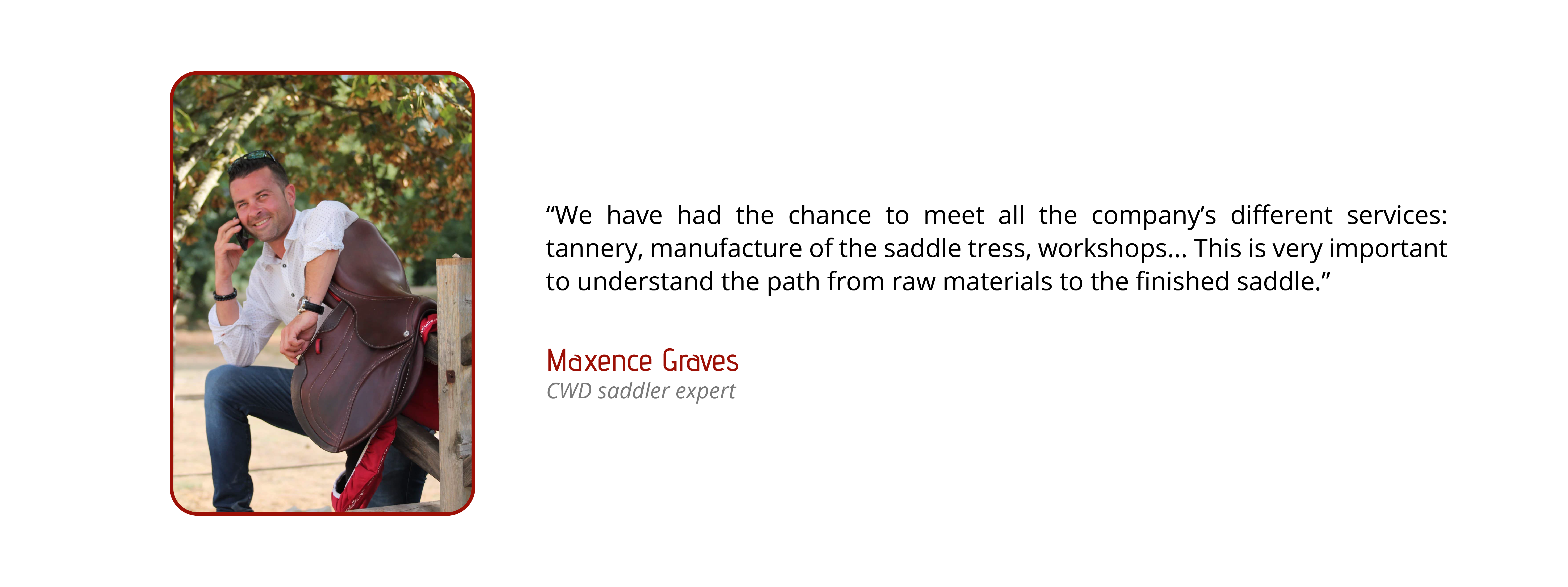
This training course is also coupled with a presentation by Pauline Martin, doctor in biomechanics. On one hand, it is about the anatomy and functioning of both rider and horse at the 3 gaits. And, on the other hand, about the different pathologies that can be revealed by the use of a non-adapted saddle.
CWD saddle experts are trained to be able to address the horse’s problems (morphology, pathologies, …) as well as those of the rider (posture, riding, evolution, …). They thus know the needs and constraints of both athletes. And they can therefore accompany them in the best way possible towards performance; while still preserving their physical integrity and well-being.
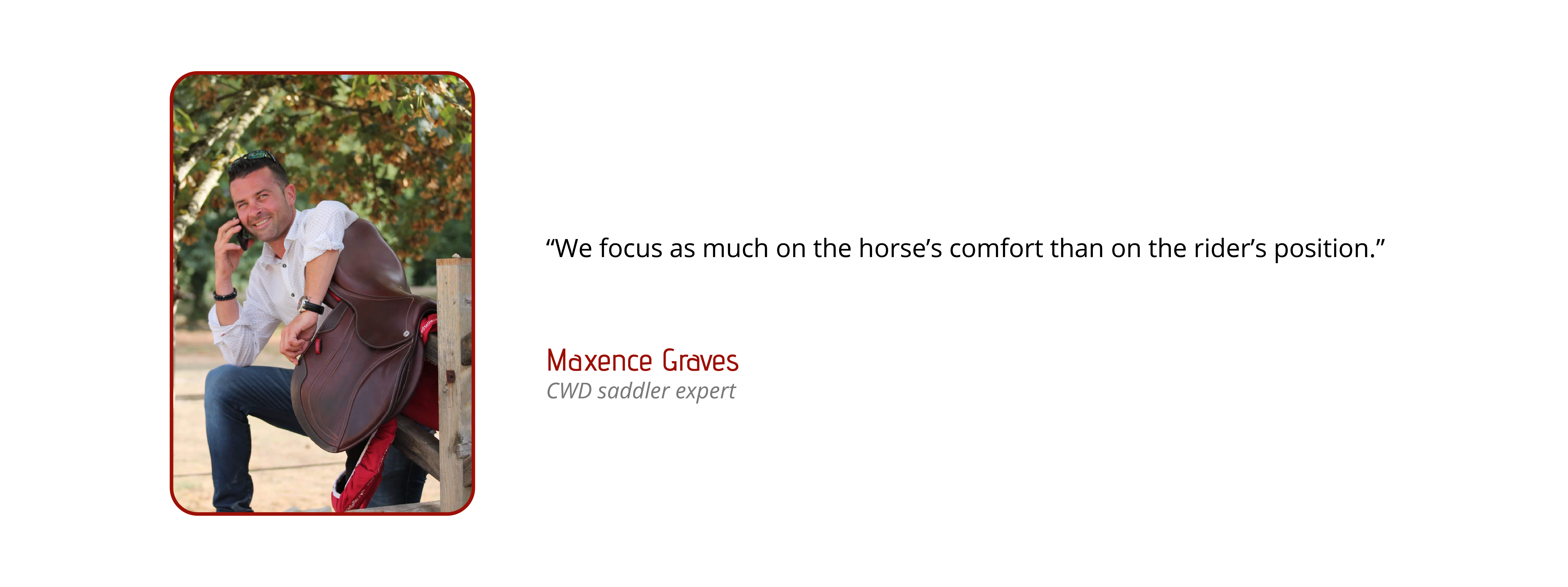
The saddle is the main interface between the horse and the rider. Each athlete has a different morphology and way of riding. An adapted saddle makes it possible to respect each one’s physiognomic criteria.
An unfitting saddle constrains the horse in its movements, thus impacting its performances. But it can also have more important consequences on its health, physical aspect and even its behavior. Indeed, many pathologies tend to appear with the use of inadequate equipments: lameness, back pain, lumbago, and other muscular or ligament atrophies.

In order to adapt the saddle to the horse, the saddle expert will of course analyze the horse’s overall morphology, but not only! He observes the horse when it is standing still and then in motion, in order to understand how it moves. He also tries to learn more about the horse:
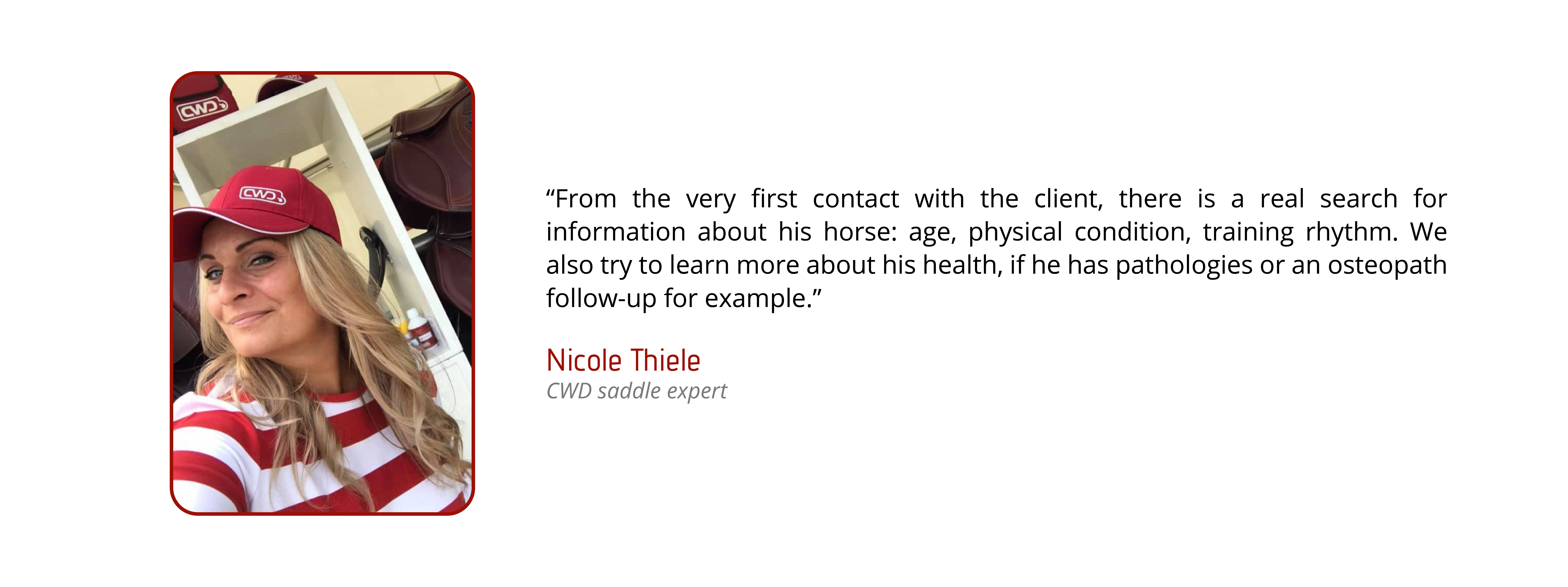
This information is essential to understand the horse’s locomotion. It allows the saddle expert to offer the appropriate equipment, which respects the functioning and comfort of both horse and rider, regardless of the efforts made while riding.
Indeed, the horse’s back undergoes great morphological changes during efforts, especially when jumping. Here, saddle fitting ensure that the saddle correctly follows the horse’s movements, rather than hindering it. This is made possible by choosing the right saddle tree — shape, materials, … —, panels and padding, as well as on the balance and overall ergonomics of the saddle.
A saddle may seem to be suitable when placed on the horse’s back at standstill, but prove to be inadequate when being set in motion. For a most accurate saddle fitting possible, it is therefore necessary to carry out static as well as dynamic checks.
The control points during saddle fitting are numerous and vary according to the horse’s morphology, the saddle’s design or the panels’ characteristics.
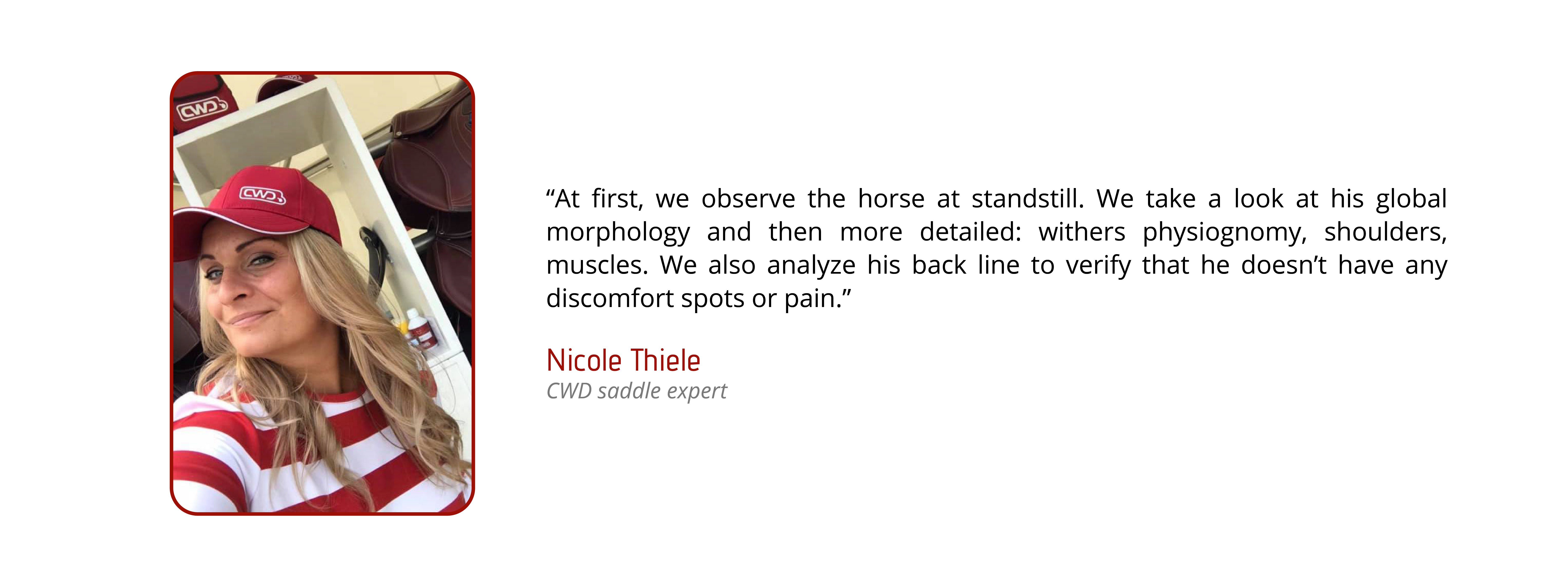
Morphological aspects are very important indicators for saddle fitting. The aspect of the back line (taut or loosened) and of the withers (protruding or rather hidden into the mass) are therefore elements to be taken into account.
Here, the saddle should be placed bareback on the horse. It allows to check its overall balance, without the interference of a saddle pad and/or a shock absorber pad.


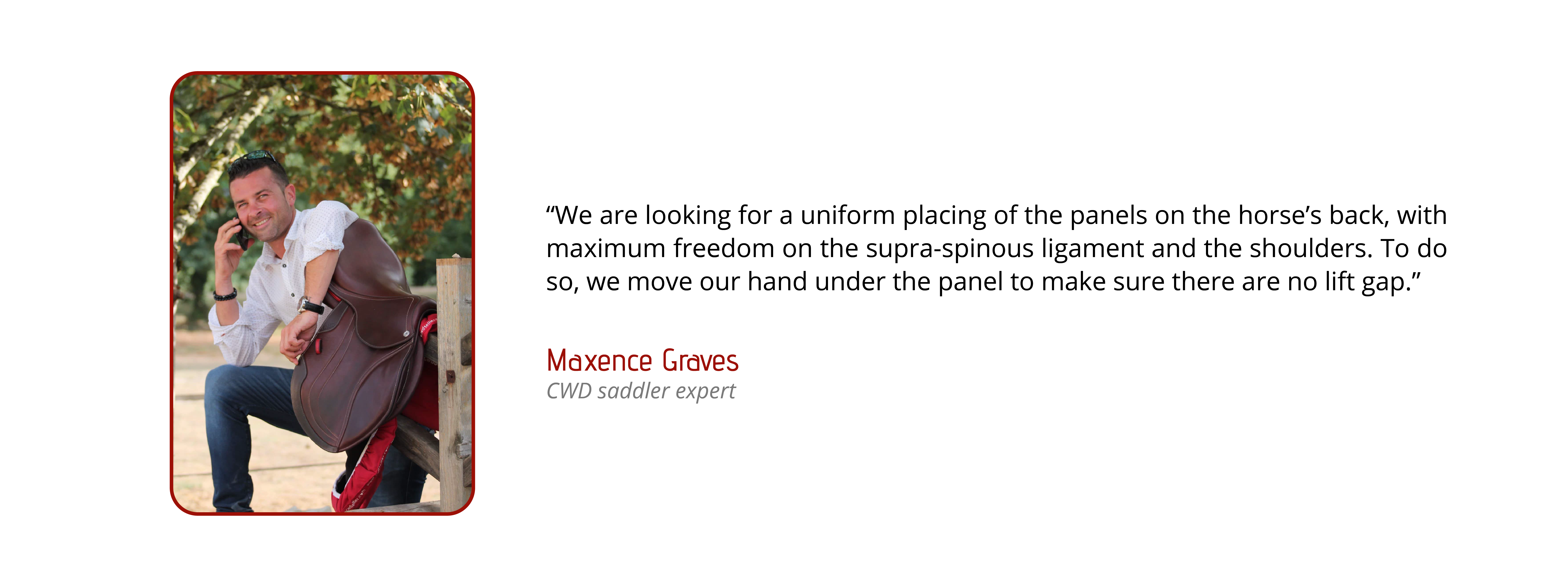
Thus, the saddle expert ensure that the saddle doesn’t hinder the horse’s freedom of movement and that pressures are distributed evenly so as not to create discomfort zones.
Thanks to this information, the saddle expert can then judge if the saddle is adapted or not to the horse’s morphology and functioning. Of course, at CWD, our saddle experts are able to perfectly adjust the saddles thanks to numerous configurations by playing on the thickness of materials in the different parts of the saddle, and mainly the panels.
The panels, made of foams of different densities, allow a better distribution of pressure and the absorption of the rider’s movements.
It is essential that the saddle is adapted to the horse, but it must also be so for the rider. An ergonomic saddle for the rider must respect his posture and functioning, but also his morphology and above all his sensations!
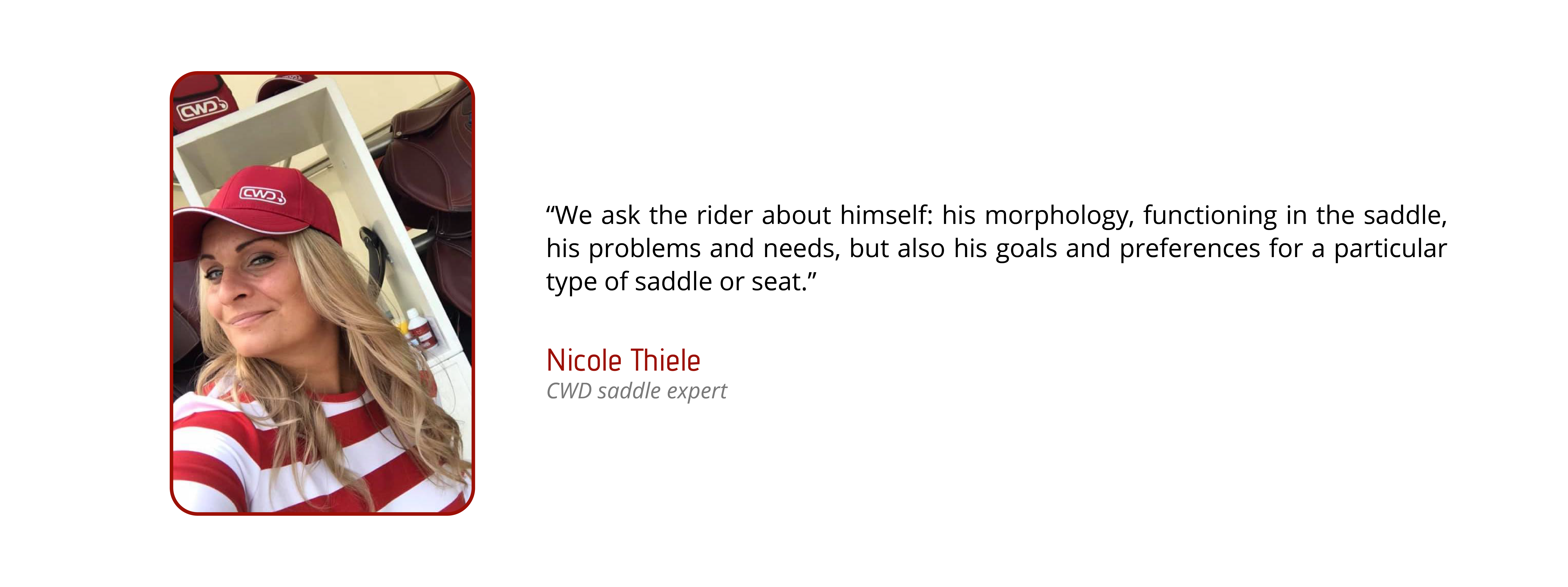
Here are some of the control points that allows the saddle expert to provide you with a well-fitted saddle:
Here, we are searching for the most suited size and shape of flaps for the rider. It depends on his morphology, but also the way he puts his stirrups on.

Indeed, the good orientation of the femur ensures that the rider keeps some support without being blocked in his functioning.
For example, if the rider’s stirrups length is quite long, his femur axis will be more vertical and the angle between his femur and shin will be more open. The saddle expert will therefore advise you to use a flap shape that is longer and advanced from below.
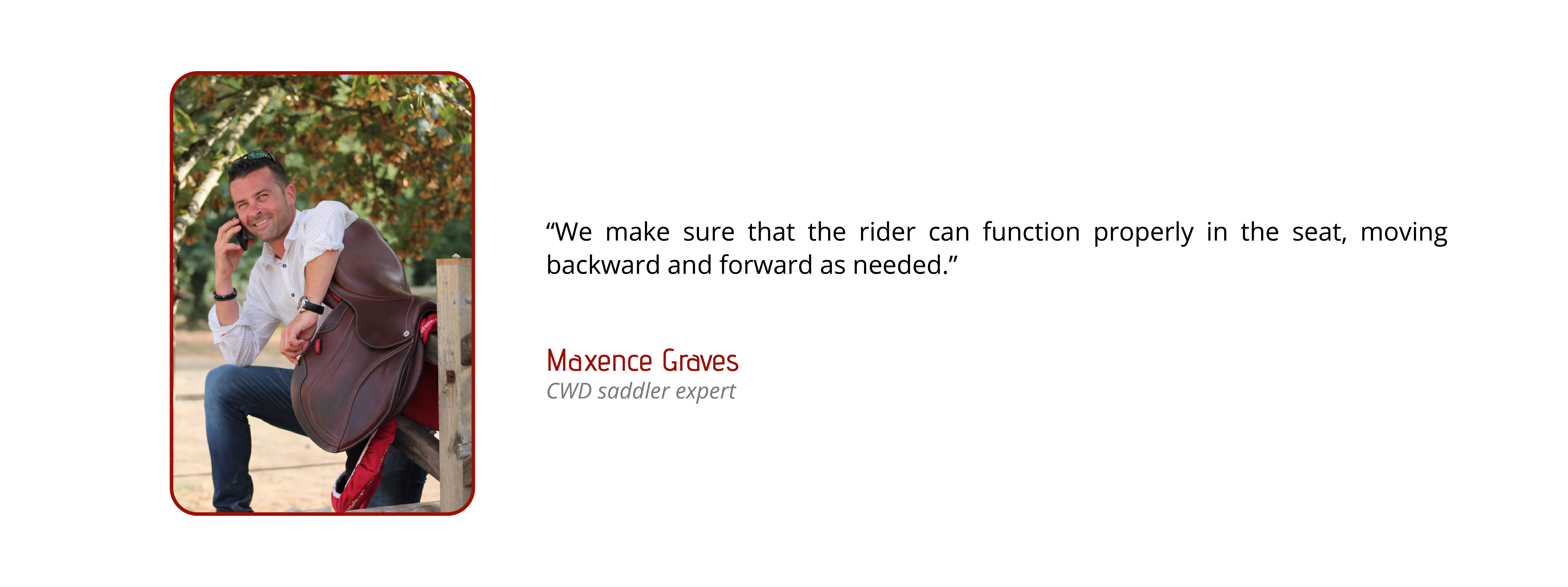
This ensures that the rider can function naturally with a free pelvis, allowing him to connect with his horse.
The rider’s sensations are also important when choosing the size and shape of the saddle seat. Some will prefer a flat seat, that offers greater freedom of movement. Others will prefer a deeper seat, that allows for more engagement of the pelvis.
It is important for the saddle expert to be able to analyze the rider and horse pair in motion. It is what will allow him to verify that the saddle is well-fitted or that there are still adjustments to make.

A saddle that perfectly fits the horse’s morphology and the rider’s functioning is essential to practice horse riding in complete safety, and with respect for both athletes’ physical integrity. However, physical condition and appearance can evolve over time and depending on different parameters such as training, age, health and diet. It is therefore necessary to have your equipment checked frequently.
Contact your CWD saddle expert to make an appointment in order to confirm that your equipment is well-fitted. Of course, your saddle can be readjusted in our workshops if necessary.